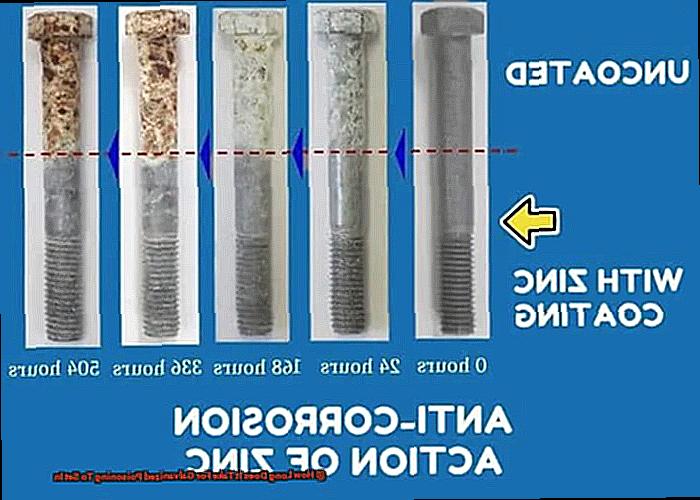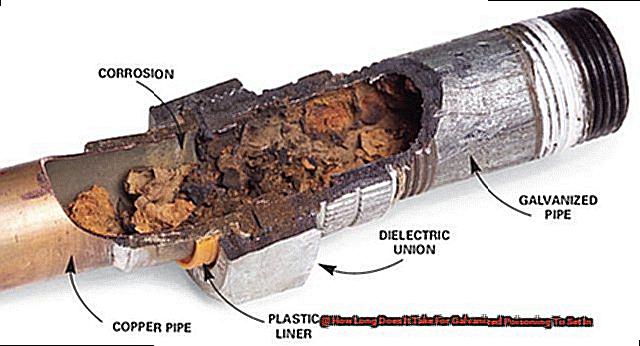Welcome to our blog, where we strive to keep you informed about important health issues that may impact you and your loved ones.
Today, we are delving into the dangerous world of galvanized poisoning – a condition that has been causing concern in recent years. You may have come across it in the news or heard whispers from friends and family, but what exactly is galvanized poisoning?

Simply put, it is a form of metal toxicity caused by exposure to zinc or its compounds, commonly found in galvanized metals like pipes and fences. While it may not seem like a major threat, galvanized poisoning can have serious consequences on one’s well-being if left untreated.
So let’s take a closer look at this topic and discover ways to safeguard ourselves from this potentially harmful condition.
How Long Does It Take For Galvanized Poisoning To Set In?
Contents
- 1 How Long Does It Take For Galvanized Poisoning To Set In?
- 2 The Effects of Zinc Exposure on the Human Body
- 3 Factors Affecting the Onset of Galvanized Poisoning
- 4 Acute vs. Chronic Zinc Toxicity: Differences and Symptoms
- 5 How Long Does It Take for Symptoms to Appear?
- 6 Early Signs and Symptoms of Galvanized Poisoning
- 7 Seeking Medical Attention and Treatment Options
- 8 Conclusion
As a skilled welder, you are well aware of the crucial safety measures to be taken while working with galvanized metals. However, do you have an accurate understanding of how long it takes for galvanized poisoning to set in after exposure? This is a question that has been asked repeatedly but seldom answered correctly. In this blog article, we will delve into the complexities of galvanized poisoning and equip you with the necessary knowledge to safeguard yourself from this grave health concern.
What exactly is Galvanized Poisoning?
Galvanized poisoning, also known as zinc toxicity or metal fume fever, is a type of heavy metal poisoning that occurs when a person is exposed to high levels of zinc. This can happen through inhalation, ingestion, or skin contact with zinc-containing materials. For welders, the most common mode of exposure is through inhaling fumes emitted by heated galvanized metals.
Zinc is a vital mineral essential for the proper functioning of our bodies. However, when exposed to excessive amounts, it can be harmful and lead to various health complications. The severity of symptoms varies depending on the level and duration of exposure, as well as the overall health of the individual.
How Long Does It Take For Symptoms To Appear?
The onset time for galvanized poisoning after exposure varies depending on multiple factors. According to research, symptoms may surface anywhere between 4-8 hours post-exposure. However, in some cases, it may take up to 24 hours for symptoms to manifest. This delayed appearance can be perilous as individuals may not realize they have been exposed and continue working in a hazardous environment.
The duration and intensity of symptoms also rely on the level of exposure. In cases of short-term exposure, symptoms may last for 2-3 days. However, for those constantly exposed to zinc fumes, the effects can persist for weeks or even months.
The Effects of Zinc Exposure on the Human Body
As a welder, you are well aware of the use of galvanized materials in your craft. These materials are coated with zinc to protect against corrosion, making them popular in various industries. However, what many may not realize is that excessive zinc exposure from these materials can have serious consequences on one’s health.
Known as zinc toxicity or galvanized poisoning, this occurs when the body is exposed to high levels of zinc. This exposure can occur through inhalation or ingestion of zinc particles, causing detrimental effects on the human body.
But what exactly happens when the body is overwhelmed with zinc? In the short term, one may experience mild symptoms such as nausea, vomiting, and diarrhea. While these may subside within a few hours, prolonged and chronic exposure can lead to more severe health issues.
One potential effect of zinc exposure is damage to the respiratory system. When inhaled, zinc particles can irritate and harm the lungs’ lining, resulting in respiratory problems like coughing, chest pain, and difficulty breathing. In some cases, this can even lead to chronic respiratory diseases such as bronchitis and emphysema.
The central nervous system is also highly sensitive to zinc exposure. Prolonged exposure to high levels of zinc can cause neurological symptoms such as numbness, tingling in the extremities, coordination problems, and even seizures. In severe cases, it can cause permanent nerve damage.
But that’s not all – long-term exposure to excessive amounts of zinc has also been linked to kidney damage. As the kidneys filter waste products from the blood, including excess minerals like zinc, prolonged exposure can overwhelm and harm them. This can result in a decline in kidney function and potentially irreversible kidney failure.
So how long does it take for galvanized poisoning to occur? The answer varies depending on individual susceptibility and level of exposure.
Factors Affecting the Onset of Galvanized Poisoning
If you’re a welder, you’re no stranger to the importance of galvanized materials in your line of work. But what you may not realize is that prolonged exposure to zinc from these materials can have serious consequences for your health. This toxic reaction, known as galvanized poisoning or metal fume fever, can result in respiratory issues, neurological symptoms, and even kidney damage.
So how exactly does this toxic reaction occur? And what factors can influence its onset? In this article, we’ll delve into the various elements that can lead to galvanized poisoning and discuss ways to protect yourself from this condition.
The Duration and Intensity of Exposure
One of the primary factors that can contribute to galvanized poisoning is the duration and intensity of exposure to zinc oxide fumes or dust. The longer you are exposed to these substances, the higher the risk of developing symptoms. Additionally, the concentration of zinc oxide in the air also plays a significant role in determining the severity of poisoning. The higher the concentration, the greater the likelihood of experiencing severe symptoms.
Individual Susceptibility
Another crucial factor that can influence the onset of galvanized poisoning is individual susceptibility. Some people may be more sensitive to zinc oxide fumes and dust than others, making them more vulnerable to developing symptoms. This susceptibility can be influenced by various factors such as pre-existing respiratory conditions, previous exposure to similar substances, and overall health status.
Type of Welding Process
The type of welding process being used can also play a significant role in the onset of galvanized poisoning. For instance, welding processes that produce higher amounts of zinc oxide fumes, such as gas metal arc welding (GMAW) and flux-cored arc welding (FCAW), can lead to a faster onset of symptoms compared to processes that produce lower amounts, such as shielded metal arc welding (SMAW).
Acute vs. Chronic Zinc Toxicity: Differences and Symptoms
As a welder, it is crucial to have a thorough understanding of the potential health hazards associated with prolonged exposure to zinc. Galvanization, the process of coating metal surfaces with zinc to prevent corrosion, may seem like a harmless practice. However, excessive levels of zinc in the body can lead to acute or chronic toxicity, resulting in serious health complications.
Acute Zinc Toxicity: A Burst of Symptoms
Imagine suddenly experiencing a burst of symptoms after being exposed to high levels of zinc. This is known as acute zinc toxicity and can occur through accidental ingestion, inhalation, or skin contact with zinc compounds. The symptoms may range from gastrointestinal distress such as nausea, vomiting, and diarrhea to more severe conditions like liver and kidney damage. In some cases, it may even lead to respiratory distress and neurological symptoms such as confusion and tremors.
For welders, acute zinc toxicity may be a result of accidental ingestion while working on galvanized materials or inhaling fumes from them. These short-term exposures can cause a burst of symptoms within hours or days, making it essential to take precautions and wear appropriate protective gear.
Chronic Zinc Toxicity: A Prolonged Perplexity
Alternatively, chronic zinc toxicity refers to long-term exposure to lower levels of zinc over an extended period. This type of poisoning is more common in occupational settings where workers are regularly exposed to zinc fumes or dust. Unlike acute toxicity, the symptoms may not be immediately apparent and can take weeks or even months to develop. These symptoms may include loss of appetite, weight loss, fatigue, and weakened immune system.
For welders, chronic zinc toxicity is a perplexing situation as the symptoms may not be easily recognizable. However, prolonged exposure can lead to serious health issues and should not be taken lightly.
How Long Does It Take for Symptoms to Appear?
Galvanized materials may seem like a harmless everyday item, but for welders, it can pose serious health risks. While most are aware of the dangers of working in this profession, many may not know that these materials contain zinc, which can lead to poisoning if ingested or inhaled in excessive amounts. But how long does it take for symptoms to appear after exposure to galvanized materials?
The timeline for symptoms to manifest varies from person to person, depending on their individual susceptibility and level of exposure. In some cases, initial signs may appear within a few hours, including nausea, vomiting, and diarrhea. These symptoms are often mistaken for food poisoning or a stomach virus, making it challenging to pinpoint the source of the illness.
However, if an individual continues to be exposed to galvanized materials, the symptoms can intensify and become more severe. Within 24-48 hours of exposure, individuals may experience more significant signs such as abdominal pain, fever, and chills. These are warning signals that the body is trying to combat the toxic effects of zinc.
But what if an individual is continuously exposed for an extended period? Within 2-3 days, symptoms can escalate even further and affect the respiratory system, resulting in shortness of breath and chest tightness. Prolonged exposure can also cause damage to the liver and kidneys, leading to jaundice and kidney failure.
It is crucial to note that the timeline for symptoms to appear after exposure to galvanized materials is not set in stone. Some individuals may experience signs sooner or later depending on their overall health and level of exposure. In some cases, symptoms may not show until significant harm has been done to the body.
Early Signs and Symptoms of Galvanized Poisoning
As a welder, you are well aware of the potential hazards that come with working with metal. Yet, there is one type of metal that may be silently inflicting harm upon your health. Yes, galvanized metal, coated with zinc to ward off corrosion, can actually be toxic if ingested or inhaled.
The initial indications and manifestations of galvanized poisoning may seem insignificant at first glance, but they should not be underestimated. Within mere hours or days of exposure, you may experience gastrointestinal distress, including queasiness, retching, and diarrhea. These symptoms may easily be mistaken for food poisoning but can escalate if exposure to zinc persists.
Inhaling zinc fumes or dust can also result in respiratory symptoms like coughing, difficulty breathing, and wheezing. This is commonly known as “zinc shakes” or metal fume fever and can manifest within 4-8 hours of exposure. While these symptoms may subside after 24 hours, continued contact with zinc can lead to more severe complications.
It’s not just welders who face the risk of galvanized poisoning. Workers in industries such as construction, manufacturing, and agriculture may also come into contact with galvanized metal and unknowingly put their health in danger.
So, how can you safeguard yourself from galvanized poisoning? Here are a few helpful pointers:
- Always don personal protective equipment (PPE) when handling galvanized metal. This includes gloves, goggles, and a respirator.
- Avoid consuming food or beverages in areas where galvanized metal is being worked on.
- Ensure proper ventilation in work areas to reduce the presence of zinc fumes and dust in the air.
- If you experience any symptoms of galvanized poisoning, seek medical attention immediately.
Remember – early detection and treatment are crucial in preventing further complications from galvanized poisoning.
Seeking Medical Attention and Treatment Options
As a welder, you are well aware of the inherent risks that come with the job. However, did you know that galvanized poisoning is a common danger in welding? This condition, also known as metal fume fever, occurs when one inhales zinc oxide fumes, resulting in acute heavy metal toxicity. Those who work in industries involving welding, galvanizing, or hot-dip galvanizing must be knowledgeable about the symptoms and seek immediate medical attention if they suspect exposure.
The symptoms of galvanized poisoning can vary from mild to severe and may include chills, nausea, headache, muscle pain, fever, and shortness of breath. While these symptoms may not initially seem alarming, they can rapidly escalate if left untreated. Therefore, it is crucial to seek medical care as soon as possible if you experience any of these signs.
So, what steps should you take if you suspect galvanized poisoning? The first and foremost action is to remove yourself from the source of exposure. By doing so, you prevent further inhalation of zinc oxide fumes and allow your body to begin eliminating any already inhaled particles. Next, in case of severe or worsening symptoms, contact emergency services immediately. They will provide prompt medical attention and transport you to a hospital for further treatment.
Once at the hospital, a healthcare provider will conduct a thorough evaluation and may perform blood tests to check for zinc levels in your body. Oxygen therapy may also be administered to aid with breathing difficulties. Resting and staying hydrated is essential for recovery as it enables your body to flush out any remaining zinc oxide particles.
In severe cases of galvanized poisoning, chelation therapy may be recommended. This treatment involves the use of medications that bind to the zinc in your body and aid in its removal. However, prevention is always better than a cure. Employers must prioritize safety measures such as proper ventilation and providing personal protective equipment to prevent exposure in the workplace.
Do not overlook the potential dangers of galvanized poisoning.
Conclusion
In conclusion, galvanized poisoning is a grave concern that can have devastating consequences if not addressed promptly. As discussed in our blog post, this condition occurs when the body is exposed to excessive levels of zinc, commonly found in galvanized metals. The time it takes for symptoms to manifest may vary from person to person, making it crucial to be aware of the potential hazards and take necessary precautions.
The effects of zinc exposure on the human body can range from mild gastrointestinal discomfort to more severe conditions such as respiratory issues, neurological symptoms, and kidney damage. Several factors, including duration and intensity of exposure, individual susceptibility, and type of welding process, can affect the onset of galvanized poisoning.
It is crucial for welders and other professionals who work with galvanized materials to recognize the early signs and symptoms of this condition. Seeking immediate medical attention is vital in preventing further complications. Treatment options may include oxygen therapy or chelation therapy in severe cases.
We hope this blog post has provided you with valuable insights into galvanized poisoning and ways to protect yourself from its harmful effects. Remember – prevention is always better than cure.





